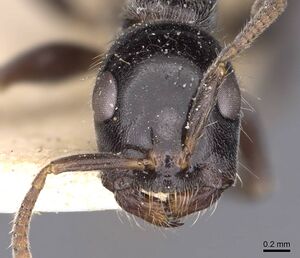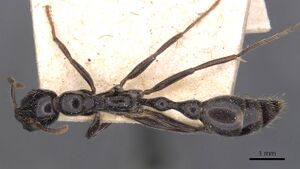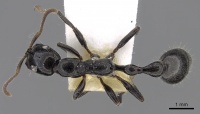Tetraponera binghami
| Tetraponera binghami | |
|---|---|

| |
| Scientific classification | |
| Kingdom: | Animalia |
| Phylum: | Arthropoda |
| Class: | Insecta |
| Order: | Hymenoptera |
| Family: | Formicidae |
| Subfamily: | Pseudomyrmecinae |
| Genus: | Tetraponera |
| Species: | T. binghami |
| Binomial name | |
| Tetraponera binghami (Forel, 1902) | |
| Synonyms | |
| |
This species appears to be confined to wet forest habitats. As far as known it always nests in the live culms of bamboos, in which the ants keep scale insects as well as brood. The nesting biology has been well studied in populations from West Malaysia, in which Gigantochloa is the host bamboo (Buschinger et a/. 1994). Here T. binghami forms large monogynous colonies, occupying multiple stem internodes, and always in association with the mealybug Kermicus wroughtoni. The workers do not aggressively defend their hostplant, however. Among other intriguing behavioral observations, colony-founding queens have been demonstrated to carry coccoids between their mandibles (Klein etal. 1992), and workers have been described bailing unwanted water out of their nests by ingestion and regurgitation (Klein et al. 1993).
| At a Glance | • Bamboo Specialist |
Identification
Ward (2001) - Characteristic features of T. binghami workers include the elongate head, prominent clypeal lobe, small eyes, well separated frontal carinae, slender mesosoma and petiole, and abundant pilosity. Compared with other Asian congeners T. binghami does not exhibit marked variation in morphology. Workers from more southern populations (Nilgiri Hills, India; West Malaysia) tend to have less elongate heads and those from southern India also have shorter petioles, but the differences are not striking.
Keys including this Species
- Key to Tetraponera males of the Oriental and Australian regions
- Key to Tetraponera of China
- Key to Tetraponera of India
- Key to Tetraponera of the Oriental and Australian regions
- Key to Tetraponera queens of the Oriental and Australian regions
Distribution
Tetraponera binghami ranges from Nepal to southern China and south to the Malay Peninsula. There is also an isolated population in the Nilgiri Hills of south India.
Latitudinal Distribution Pattern
Latitudinal Range: 27.48333333° to 2.6°.
| North Temperate |
North Subtropical |
Tropical | South Subtropical |
South Temperate |
- Source: AntMaps
Distribution based on Regional Taxon Lists
Oriental Region: India, Laos, Myanmar (type locality), Nepal, Thailand.
Palaearctic Region: China.
Distribution based on AntMaps
Distribution based on AntWeb specimens
Check data from AntWeb
Countries Occupied
| Number of countries occupied by this species based on AntWiki Regional Taxon Lists. In general, fewer countries occupied indicates a narrower range, while more countries indicates a more widespread species. |

|
Estimated Abundance
| Relative abundance based on number of AntMaps records per species (this species within the purple bar). Fewer records (to the left) indicates a less abundant/encountered species while more records (to the right) indicates more abundant/encountered species. |

|
Biology
Buschinger et al. 1994 - Dissection of 54 stem internodes from 12 different culms of the large bamboo Gigantochloa scortechinii (height up to 25 m, diameter 8-10 cm, internode length 20-60 cm), and mapping of three colonies indicate the following demographic characteristics. Colonies are monogynous but highly polydomous (at least up to 36 internodes and up to 9 stems occupied) and very populous for a pseudomyrmecine not involved in an ant-plant mutualism. One completely censused colony had 6953 adult workers and 2079 alates (adults plus pupae). Brood is distributed from the queenright chamber to all other nest chambers. The symbiotic pseudococcids Kermicus wroughtoni are present in all inhabited internodes, with small early instar individuals prevailing numerically by far over the larger stages. The reliable honeydew supply within the internodes and the efficient architectural protection provided by the internode wall (access usually only through a 2 x 3 mm-hole) allow an unusually large colony size without being an aggressive and protective plant mutualist like other members of its subfamily with similar demographics. Partner bacteria in the gut make it possible to survive on a nitrogen-poor honeydew diet Category:Ants and Bacteria.
Several unusual behaviors include ejection of excess water from the internodes (Klein et al. 1993) and carrying of pseudococcid larvae by young queens during the nuptial flight (Klein et al., 1992). Unlike some other ants specialized on a narrow range of plants, T. binghami does not protect its host.
Castes
Buschinger et al. 1994 - The ovaries of T. binghami show an adaptation for large colony size. Whereas generalized Pseudomyrmecinae tend to have 2 ovarioles per ovary (e.g., T. anthracina (Terron, 1970), T. modesta, Pseudomyrmex mexicanus, P. pallidus (unpubl. obs.), T. binghami queens have 10 ovarioles per ovary.
Worker
Images from AntWeb
   
| |
| Syntype of Sima binghami lindgreeni. Worker. Specimen code casent0907457. Photographer Will Ericson, uploaded by California Academy of Sciences. | Owned by MHNG, Geneva, Switzerland. |
   
| |
| Syntype of Tetraponera binghami. Worker. Specimen code casent0907458. Photographer Will Ericson, uploaded by California Academy of Sciences. | Owned by MHNG, Geneva, Switzerland. |
Nomenclature
The following information is derived from Barry Bolton's Online Catalogue of the Ants of the World.
- binghami. Sima binghami Forel, 1902c: 243 (w.q.m.) MYANMAR. Combination in S. (Tetraponera): Emery, 1921f: 25; in Tetraponera: Wheeler, W.M. 1921c: 531. Senior synonym of lindgreeni: Ward, 2001: 626.
- lindgreeni. Sima binghami var. lindgreeni Forel, 1902c: 245 (w.) INDIA. Combination in S. (Tetraponera): Emery, 1921f: 25; in Tetraponera: Chapman & Capco, 1951: 79. Junior synonym of binghami: Ward, 2001: 626.
Unless otherwise noted the text for the remainder of this section is reported from the publication that includes the original description.
Description
Worker
Ward (2001) - HW 1.06-1.27, HL 1.36-1.75, LHT 1.24-1.46, CI 0.70-0.78, FCI 0.16-0.20, REL 0.25-0.30, REL2 0.36-0.39, SI 0.62-0.66, SI3 1.62-1.84, FI 0.37-0.40, PLI 0.36-0.43, PWI 0.36-0.42, PDI 0.90-0.99, LHT/HW 1.05-1.20, CSC 24-40, MSC 34-71.
Large, slender species, with elongate head (CI <0.80); clypeus with moderately prominent median lobe, the anterior margin convex and weakly crenulate; frontal carinae well separated, the distance between them exceeding maximum scape width; eyes relatively small (see REL, REL2 and SI3 values); head capsule usually widest on anterior half and converging slightly posteriorly; posterior margin of head straight; profemur slender; lateral margins of pronotum not well defined; mesopropodeal impression well developed and elongate, the anterior half open and furnished with irregular rugulae, usually longitudinal in orientation; posterior half consisting of a shallow depression flanked by low metanotal tubercles that are discernable in profile; propodeum long and low (PDI <1.00), it dorsal face rounding gradually into the declivitous face; legs long relative to head size, LHT/HL 0.80-0.91; petiole long and slender (PLI <0.45), the node rather weakly differentiated from the anterior peduncle; petiole about 2.5x longer than broad; postpetiole about 1.4x longer than broad; metabasitarsal sulcus well developed, lying in a darkened patch of cuticle and subtended by a low ridge, occupying about 0.60-0.70x the length of the basitarsus; mesobasitarsus with a small remnant of a comparable sulcus. Integument with numerous fine punctures, the interspaces smooth and shiny; punctures on dorsum of head and mesosoma mostly 0.005-0.015 mm in diameter and separated by one to several diameters, less dense along mesosomal midline (especially on pronotal midline which is smooth and shiny); punctures on side of mesosoma finer, less conspicuous, except for dense patch on metapleuron and adjacent mesepisternum; lower malar area with coarse punctures intermixed with irregular longitudinal rugulae. Standing pilosity common and conspicuous on most of body (CSC >20, MSC >30), and grading into shorter suberect and decumbent pubescence. Black to dark brownish-black, tarsi and antennae often lighter (medium- to yellowish-brown).
Type Material
Ward (2001) - Syntypes, 6 workers, 1 alate queen, 3 males, Moulmain, Myanmar (Hodgson) (Museo Civico di Storia Naturale, Genoa, Musee d'Histoire Naturelle Genève); syntypes, 3 workers, Ye Valley, Myanmar (Bingham) (MHNG); syntypes, 3 workers, N. Konkan, Myanmar (Wroughton) (Naturhistorisches Museum, Basel); syntypes, 8 workers, 1 male, Assam, India (Smythies) (MHNG).
Determination Clarifications
In other publications this species has been referred to by the code name “Tetraponera sp. PSW-80”.
References
- Ward, P. S. 2001. Taxonomy, phylogeny and biogeography of the ant genus Tetraponera (Hymenoptera: Formicidae) in the Oriental and Australian regions. Invertebrate Taxonomy. 15:589-665. (page 626, Senior synonym of lindgreeni)
- Bharti, H. and Akbar, S.A. 2014. Tetraponera periyarensis, a new pseudomyrmecine ant species (Hymenoptera: Formicidae) from India. Asian Myrmecology. 6:43–48.
- Buschinger, A., Klein, R. W. & Maschwitz, U. 1994. Colony structure of a bamboo-dwelling Tetraponera sp. (Hymenoptera: Formicidae: Pseudomyrmecinae) from Malaysia. Ins. Soc. 41: 29-41. (= T. binghami)
- Dendup, K.C., Dorji, C., Dhadwal, T., Bharti, H., Pfeiffer, M. 2021. A preliminary checklist of ants from Bhutan. Asian Myrmecology 14, e014005 (doi:10.20362/am.014005).
- Emery, C. 1921c. Hymenoptera. Fam. Formicidae. Subfam. Myrmicinae. [part]. Genera Insectorum 174A:1-94 94: 1-94 + 7 (page 25, Combination in S. (Tetraponera))
- Forel, A. 1902c. Myrmicinae nouveaux de l'Inde et de Ceylan. Rev. Suisse Zool. 10: 165-249 (page 243, worker, queen, male described)
- Klein R. W. , Kovac D., Schellerich A. & Maschwitz U. 1992. Mealybug-carrying by Swarming Queens of a Southeast Asian Bamboo-inhabiting Ant. Naturwissenschaften 79, 422- 423.
- Klein R. W., Maschwitz U. & Kovac D. 1993. Flood control by ants: a Southeast Asian bamboo-dwelling Tetraponera (Formicidae, Pseudomyrmecinae) bails water from its internode nests. Ins. Soc. 40: 115-118.
- Liberti, J., Sapountzis, P., Hansen, L.H., Sørensen, S.J., Adams, R.M.M., Boomsma, J.J. 2015. Bacterial symbiont sharing in Megalomyrmex social parasites and their fungus-growing ant hosts. Molecular Ecology 24, 3151–3169 (doi:10.1111/MEC.13216).
- Radchenko, A.G., Fisher, B.L., Esteves, F.A., Martynova, E.V., Bazhenova, T.N., Lasarenko, S.N. 2023. Ant type specimens (Hymenoptera, Formicidae) in the collection of Volodymyr Opanasovych Karawajew. Communication 1. Dorylinae, Poneromorpha and Pseudomyrmecinae. Zootaxa, 5244(1), 1–32 (doi:10.11646/zootaxa.5244.1.1).
- Subedi, I.P., Budha, P.B., Bharti, H., Alonso, L. 2020. An updated checklist of Nepalese ants (Hymenoptera, Formicidae). ZooKeys 1006, 99–136 (doi:10.3897/zookeys.1006.58808).
- Subedi, I.P., Budha, P.B., Thapa, V.K. 2022. Ant genus Tetraponera Smith, 1852 in Nepal, with two new records and keys to workers (Formicidae: Pseudomyrmecinae). Journal of Institute of Science and Technology, 27(1): 93-99 (doi:10.3126/jist.v27i1.46661).
- Wheeler, W. M. 1921c. Chinese ants. Bulletin of the Museum of Comparative Zoology 64: 529-547 (page 531, Combination in Tetraponera)
References based on Global Ant Biodiversity Informatics
- Dlussky G. M.; Radchenko A. G. 1990. The ants (Hymenoptera, Formicidae) of Vietnam. Subfamily Pseudomyrmicinae. Subfamily Myrmicinae (tribes Calyptomyrmecini, Meranoplini, Cataulacini). Pp. 119-125 in: Akimov, I. A.; Emelianov, I. G.; Zerova, M. D. et al. (eds.) 1990. News of faunistics and systematics. [In Russian.]. Kiev: Naukova Dumka, 184 pp.
- Guénard B., and R. R. Dunn. 2012. A checklist of the ants of China. Zootaxa 3558: 1-77.
- Jaitrong W., B. Guenard, E. P. Economo, N. Buddhakala, and S. Yamane. 2016. A checklist of known ant species of Laos (Hymenoptera: Formicidae). Asian Myrmecology 8: 1-32. DOI: 10.20362/am.008019
- Jaitrong W.; Nabhitabhata, J. 2005. A list of known ant species of Thailand. The Thailand Natural History Museum Journal 1(1): 9-54.
- Kadoorie Farm & Botanic Garden, 2002. Report of Rapid Biodiversity Assessment at Heweishan Forest Farm, Southwest Guangdong, 4 to 5 May 1998. South China Forest Biodiversity Survey Report Series (Online Simplified Version): No. 6. KFBG, Hong Kong SAR, ii + 15 pp.
- Li Z.h. 2006. List of Chinese Insects. Volume 4. Sun Yat-sen University Press
- Santschi F. 1920. Fourmis d'Indo-Chine. Annales de la Société Entomologique de Belgique 60: 158-176.
- Santschi F. 1924. Fourmis d'Indochine. Opuscules de l'Institut Scientifique de l'Indochine 3: 95-117
- Tiwari R.N., B.G. Kundu, S. Roychowdhury, S.N. Ghosh. 1999. Insecta: Hymenoptera: Formicidae. Pp. 211-294 in: Director; Zoological Survey of India (ed.) 1999. Fauna of West Bengal. Part 8. Insecta (Trichoptera, Thysanoptera, Neuroptera, Hymenoptera and Anoplura). Calcutta: Zoological Survey of India, iv + 442 pp.
- Ward P. S. 2001. Taxonomy, phylogeny and biogeography of the ant genus Tetraponera (Hymenoptera: Formicidae) in the Oriental and Australian regions. Invertebrate Taxonomy 15: 589-665.
- Ward, P. S. 2001. Taxonomy, phylogeny and biogeography of the ant genus Tetraponera (Hymenoptera: Formicidae) in the Oriental and Australian regions. Invertebrate Taxonomy 15:589-665.
- Wheeler W. M. 1921. Chinese ants. Bulletin of the Museum of Comparative Zoology 64: 529-547.
- Wheeler W. M. 1930. A list of the known Chinese ants. Peking Natural History Bulletin 5: 53-81.
- Xu Z. and Z.-Q. Chai. 2004. Systematic study on the ant genus Tetraponera F. Smith (Hymenoptera, Formicidae) of China. Acta Zootaxonomica Sinica 29(1): 63-76.
- Zhang R. J., L. W. Liang, and S. Y. Zhou. 2014. An analysis on the ant fauna of Nonggang Nature Reserve in Guangxi, China. Journal of Guangxi Normal university: Natural Science Edition 32(3): 86-93.
- Zryanin V. A. 2011. An eco-faunistic review of ants (Hymenoptera: Formicidae). In: Structure and functions of soil communities of a monsoon tropical forest (Cat Tien National Park, southern Vietnam) / A.V. Tiunov (Editor). – M.: KMK Scientific Press. 2011. 277 р.101-124.



